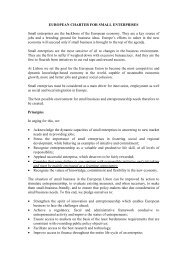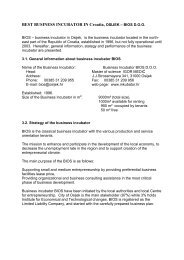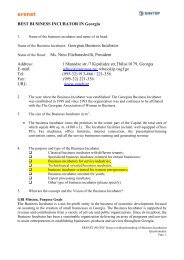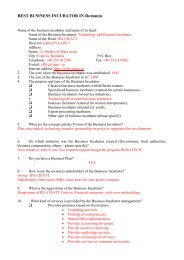Strategies of the Development of Entrepreneurship and SME
Strategies of the Development of Entrepreneurship and SME
Strategies of the Development of Entrepreneurship and SME
Create successful ePaper yourself
Turn your PDF publications into a flip-book with our unique Google optimized e-Paper software.
While comparing <strong>the</strong> BSEC <strong>and</strong> EU documents, it is clear that some <strong>of</strong> <strong>the</strong> key-areas areoverlapping each o<strong>the</strong>r, whe<strong>the</strong>r it is a country with several hundred year <strong>of</strong> experience inmarket-economy, or it is a newcomer. However, several key areas are irrelevant to <strong>the</strong>transition economies <strong>and</strong> it was strange, that <strong>the</strong> EU forced <strong>the</strong>se countries also to make anevaluation report on all requirements. The most contradictory item is <strong>the</strong> point “getting moreout <strong>of</strong> <strong>the</strong> Single Market” for countries, which are not EU members.The United Nations Economic Commission for Europe (UNECE) developed anINTEGRATED MODEL FOR THE DEVELOPMENT OF THE <strong>SME</strong> SECTOR IN THE COUNTRIESIN TRANSITION, which is successfully implemented in <strong>the</strong> majority <strong>of</strong> <strong>the</strong> BSEC <strong>and</strong> CEEtransition economies. The most effective way <strong>of</strong> development <strong>of</strong> entrepreneurship is taking placewhen activities <strong>and</strong> assistance are integrated <strong>and</strong> aimed at three distinct levels: 8 9Strategic level – policymaking (hierarchy 1)• Task: <strong>Development</strong> <strong>of</strong> sustainable environment, commitment to promote <strong>the</strong> creation<strong>and</strong> growth <strong>of</strong> <strong>SME</strong>s by, inter alia, elaborating policy measures <strong>and</strong> legal instruments tosupport small- <strong>and</strong> medium-sized industries <strong>and</strong> business entities to facilitate <strong>the</strong> access<strong>of</strong> <strong>SME</strong>s to technological <strong>and</strong> financial resources <strong>and</strong> stimulate investment <strong>and</strong> privatesector involvement in <strong>the</strong> <strong>SME</strong> sector• Responsible: Legislative <strong>and</strong> government administrative bodies with delegated tasks <strong>of</strong>planning <strong>and</strong> implementing <strong>SME</strong> promotion programmes.Institutional level - support institutions (hierarchy 2)• Task: Establishment <strong>and</strong> streng<strong>the</strong>ning infrastructure (independent institutions <strong>and</strong>mechanisms) to promote <strong>SME</strong>s by providing effective services, including information onhow to start up a business, how to prepare business plans, how to get partners <strong>and</strong>marketing information, access to financial resources <strong>and</strong> credit guarantees,development <strong>of</strong> a market-oriented way <strong>of</strong> thinking, support for innovation <strong>and</strong>facilitating cooperation among <strong>SME</strong>s, etc.• Responsible: Public <strong>and</strong> private sector institutions, chambers <strong>of</strong> commerce, nongovernmentalorganizations, pr<strong>of</strong>essional <strong>and</strong> social associations, training institutions,national development boards, banks.Enterprise level – entrepreneurs <strong>and</strong> business entities (hierarchy 3)• Task: <strong>Development</strong> <strong>of</strong> entrepreneurship <strong>and</strong> supporting <strong>SME</strong>s within an integratedprogramme approach <strong>and</strong> sub-sectoral systems by streng<strong>the</strong>ning entrepreneurial <strong>and</strong>managerial skills, providing direct consulting services, establishing industrial estates <strong>and</strong>business centres, developing quality awareness <strong>and</strong> promoting internationalization <strong>of</strong><strong>SME</strong>s, providing testing <strong>and</strong> certification possibilities, developing awareness forconsumer protection, etc.• Responsible: Small <strong>and</strong> medium-sized enterprises, entrepreneurs, universities, testinginstitutions, certification bodies, consumer protection body, consulting companies.The above-mentioned levels create an <strong>SME</strong> <strong>Development</strong> Pyramid structure in which <strong>the</strong>strategic level is considered as <strong>the</strong> highest priority <strong>and</strong> is "located" at <strong>the</strong> tip <strong>of</strong> <strong>the</strong> pyramid.The institutional level is located in <strong>the</strong> middle <strong>and</strong> is interlinked with both <strong>the</strong> <strong>SME</strong> policymakersat <strong>the</strong> top <strong>and</strong> <strong>the</strong> entrepreneurs at <strong>the</strong> bottom for whom <strong>the</strong>y are created <strong>and</strong> towhom <strong>the</strong>ir services are <strong>of</strong>fered. The third level is <strong>the</strong> base <strong>of</strong> <strong>the</strong> whole structure: <strong>the</strong>y are <strong>the</strong>actors <strong>of</strong> <strong>the</strong> <strong>SME</strong> sector whose performance, behaviour, efficiency <strong>and</strong> inefficiency arereflected in <strong>the</strong> mirror <strong>of</strong> economic transformation. The whole building is sound only when <strong>the</strong>reis mutual development, acceptance by each o<strong>the</strong>r <strong>and</strong> operative cooperation.8 http://www.unece.org/indust/region2.htm9 Dr. Antal Szabó: <strong>Development</strong> <strong>of</strong> <strong>Entrepreneurship</strong> <strong>and</strong> <strong>SME</strong>s in SEE <strong>and</strong> CITs.http://unece.org/ie/wp8/documents/mayfor/Szabo.pdf6
















